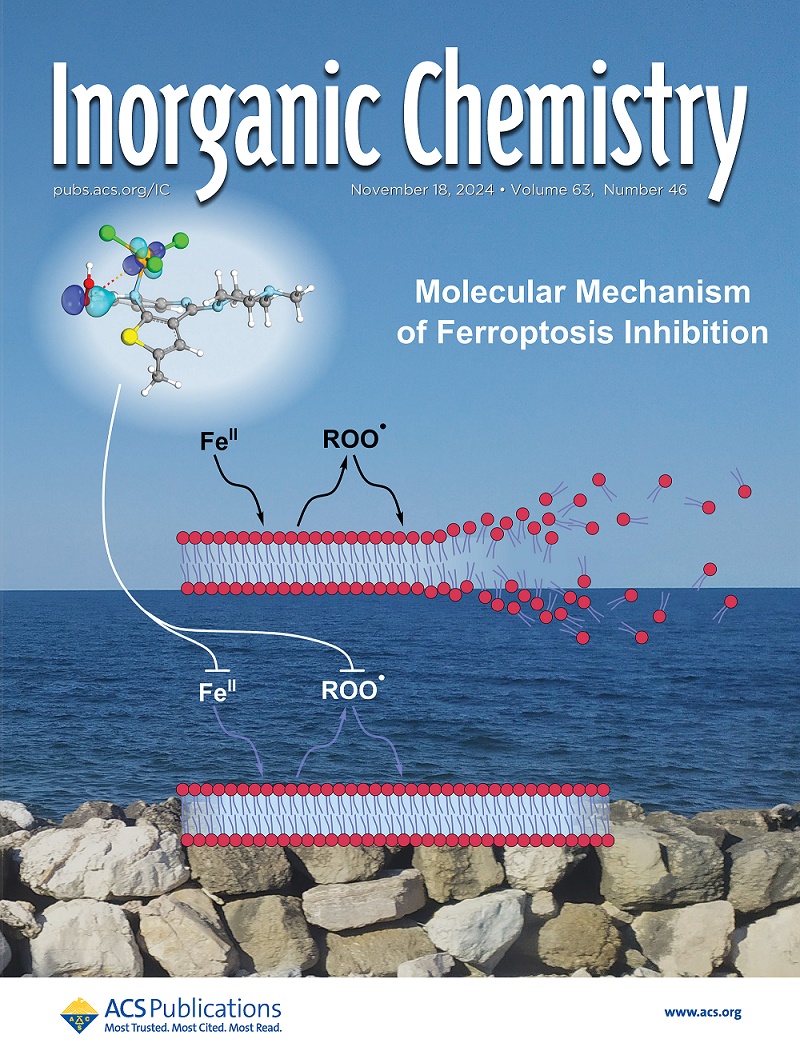Hydrolytic Cleavage and Deborylation of Boron(III) Subphthalocyanines─A Synthetic Approach to Fused Diazatripyrrins.
IF 4.7
2区 化学
Q1 CHEMISTRY, INORGANIC & NUCLEAR
引用次数: 0
Abstract
Boron(III) subphthalocyanine analogues with enhanced electron affinity in the presence of water undergo hydrolytic cleavage of the macrocycle and deborylation, resulting in formation of noncyclic aza-bridged tris-isoindoles, which are fused derivatives of 5,10-diazatripyrrines (DATRIPY). Spectral data, kinetic studies, and DFT results allow us to suggest a plausible mechanism of DATRIPY formation, which includes nucleophilic addition of water to one of the CαNmeso bonds and its rupture as a key stage. This reaction is possible for perhalogenated or/and azasubstituted boron(III) subphthalocyanine analogues and occurs especially easily for hexachlorinated tripyrazinosubporphyrazinatoboron(III) chloride, affording the corresponding 14-amino-5,10-diazatripyrrin-1-one [DATRIPY1a] bearing fused dichloropyrazine fragments in each pyrrole unit. An X-ray diffraction study revealed that DATRIPY1a has an S-like conformation, which is stabilized by two intramolecular hydrogen bonds between pyrrolic NH groups and pyrrolenine and pyrazine nitrogens. DATRIPY1a reacts with BF3, forming a noncyclic tripyrrolic bis-boron(III) complex [BODATRIPY] in which two BF2 fragments are bonded by pyrrole-pyrrolenine and pyrrole-pyrazine coordination sites. Due to rearrangement of intramolecular H-bonds occurring in aprotic and proton donor solvents, DATRIPY1a exhibits strong solvatochromism and can also be used as a colorimetric sensor for the presence of hard anions (fluoride, hydroxide, cyanide, and cyanate).亚酞菁硼(III)的水解裂解和波酰化─熔融重氮吡啶的合成方法。
硼(III)亚酞菁类似物在水的存在下具有增强的电子亲和性,通过水解裂解大环和deborylation,形成非环偶氮桥接的三异吲哚,这是5,10-重氮吡啶(DATRIPY)的融合衍生物。光谱数据、动力学研究和DFT结果使我们提出了一种似是而非的DATRIPY形成机制,其中包括在c α - nmeso键上亲核加成水及其断裂是关键阶段。这一反应可能发生在过卤化或/和偶氮取代的硼(III)亚酞菁类似物中,尤其容易发生在六氯化的三吡嗪亚卟啉(III)氯化物中,在每个吡咯单元中提供相应的14-氨基-5,10-重氮吡啶-1- 1 [DATRIPY1a]含有融合的二氯吡嗪片段。x射线衍射研究表明,DATRIPY1a具有s型构象,它由两个分子内氢键稳定在pyrolic NH基团和pyrolinine和pyrazine氮之间。DATRIPY1a与BF3反应,形成非环三吡咯二硼(III)配合物[BODATRIPY],其中两个BF2片段通过吡咯-吡咯啉和吡咯-吡嗪配位位点结合。由于分子内氢键重排发生在非质子和质子供体溶剂中,DATRIPY1a表现出强烈的溶剂致色性,也可以用作硬阴离子(氟化物,氢氧化物,氰化物和氰酸盐)存在的比色传感器。
本文章由计算机程序翻译,如有差异,请以英文原文为准。
求助全文
约1分钟内获得全文
求助全文
来源期刊

Inorganic Chemistry
化学-无机化学与核化学
CiteScore
7.60
自引率
13.00%
发文量
1960
审稿时长
1.9 months
期刊介绍:
Inorganic Chemistry publishes fundamental studies in all phases of inorganic chemistry. Coverage includes experimental and theoretical reports on quantitative studies of structure and thermodynamics, kinetics, mechanisms of inorganic reactions, bioinorganic chemistry, and relevant aspects of organometallic chemistry, solid-state phenomena, and chemical bonding theory. Emphasis is placed on the synthesis, structure, thermodynamics, reactivity, spectroscopy, and bonding properties of significant new and known compounds.
 求助内容:
求助内容: 应助结果提醒方式:
应助结果提醒方式:


